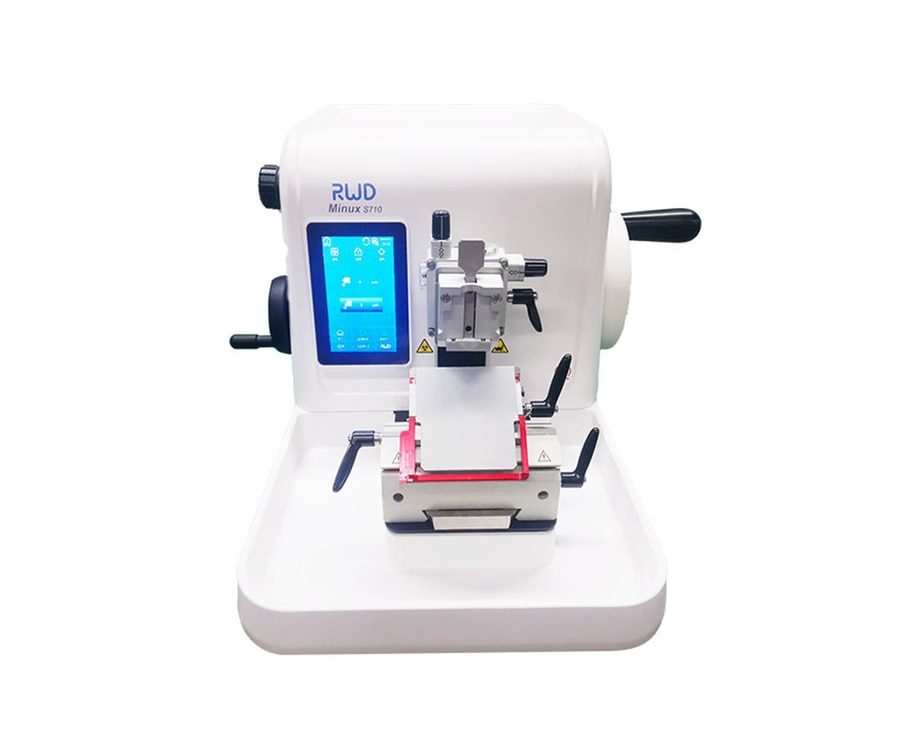
#Product Trends
Precautions of Using A Rotary Microtome During Trimming, Sectioning and Mounting
Paraffin sectioning is the most used technique in histopathology.
Its protocol can be complicated, and any miss in any step may affect the quality of the sectioning. In the previous article, we discussed about common microtome tissue sectioning troubleshooting and tips. In this issue, we will take a closer look at the precautions when operating paraffin microtome from trimming, slicing to mounting, and talk about one of the most pain point- the alternate thick and thin sections.
1 Trimming
Trimming is normally done at a thickness of 20-30 µm.
Recommend trimming the tissue to the thickness of 20-30 µm.
For harder tissue or smaller tissue, it should be thinner. A standard trimming is completed when the whole tissue is exposed.
2 Sectioning
The quality microtome blade must be sharp and free of notches, and regularly replaced. This can make up for the misses in the pre-treatment process.
Before sectioning: Tightening the knife clamper, knife holder and sample block holder, and trimming the slice until the tissue is fully exposed.
During sectioning: the handwheel should be turned at a uniform speed. if it is too fast, it will result in uneven thickness of sectionings (slice jumping), wearing the knife holder; if it's too slow, it will thicken the sectionings. The sectioning thickness is generally set at 3~5 μm. A standard section should keep the tissue integral and uniform with an even thickness. The incomplete tissue sections may leave misdiagnosis and omission.
Tips: The direction of the tissue being embedded. The layers of the tissue, the direction of its fibers, muscles, etc. should be parallel to the knife. The difficult parts to be cut should be placed on top when embedding, such as the epidermis of the skin, the envelope of the mass and the serosa of the gastrointestinal tract to minimize the breakage of tissue sections. After cutting out the required slices, the slices will be taken out with forceps and put into the water bath or spread out on the baking machine.
Reminder:
The microtome should be checked for proper functioning before sectioning. For hard tissues such as decalcified tissue, bone marrow, uterine fibroids and calcified tissue, the same blade edge should be used wherever possible to reduce the possibility of damage to blade.
When spreading the sections or cleaning up, the brush should go upwards, as going downwards can easily cause the brush threads to be cut by the blade, resulting in damage to the blade.
3 Mounting
Putting the sections in the waterbath to flatten and smoothen. If the sections are still wrinkling, add alcohol solution to water as it lowers the surface tension and removes wrinkles.
The high-quality slice is picked out and mounted on the slide at its 1/3 location from one of its sides. The slide will be labeled for identification. The general water temperature to float slices is about 40℃.
4 Alternate thick and thin sections
It may be taken for granted that if the thickness of the section is set on the machine, the slices will come out at the desired thickness, and must be the desired thickness, otherwise the machine must be inaccurate. However, there are several other factors that can cause alternating thick and thin sections.
For instance, the blade edge is not sharp or the sectioning speed is not uniform-slow sectioning results in thicker slices. Only a sharp blade with an uniform sectioning stroke can guarantee sectioning of uniform thickness.
In addition, the ambient temperature may also cause the wax block to heat up, making the sections thicker. In short, alternate thick and thin sections must be analyzed according to the actual situation.
RWD Minux® rotary microtome S710 can effectively solve the problem of abnormal thickness and ensure the section quality.
The unique feature is combining manual sectioning and semi-automated setup, ensuring microtome sectioning precision, meeting the various habits of most operators. It reduces the occurrence of slice jumping in sectioning hard tissues and ensures the completeness and continuity of sections. In addtion, it features low-cost maintenance.








